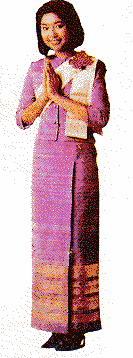|
Namaste Or Namaskara > Page1
Dear Visitor,
I welcome you to this non-profit, educational page. Here you will read about different aspects of the history and culture of that part of our globe which is known variously as Bharatvarsha, Hindostan or India. My approach of looking at history is that of a rationalist and humanist. As my aim is to spread awareness about history and culture, you may freely download this page, print it, link it up from your site, or mirror it at any server. Enjoy the infotainment laid out for you at this site. I also look forward to your valuable suggestions and feedback. Happy viewing.
Author
Hindu History
Hindu Etiquette
- Namaskara And Tilaka
- by Shri Sudheer Birodkar
Namaste Or Namaskara
Namaste or Namaskara is the traditional Indian form of salutation. It is used while greeting friends and acquaintances as also while paying obeisance to God. As a word it finds its place in the invocation to our different Gods, for instance we have Shri Ganeshaya Namaha Aum Namaha Shivaya, Krishnaya Tubhyam Namaha etc.
Namaste could be an amalgam of Namsya (or Namaha) meaning obeisance and 'Te' which means you or to you. Thus Namaste as an amalgam of Namasyate could be translated as obeisance to you. Namaste involves the joining together of both palms at the level of the breast. If the person being greeted is a senior or if it is addressed to God, the Namaste is accompanied with a slight bow. This bow can be termed a slight one for it is only a downward inclination of the head unlike the Japanese bow where the body is bent at right angles at the hip.
The origin of this graceful and modest form of greeting can only be guessed. Its literal meaning is an indication of it origin. Namaste could be an amalgam of Namsya (or Namaha) meaning obeisance and 'Te' which means you or to you. Thus Namaste as an amalgam of Namasyate could be translated as obeisance to you.
The meaning implies a submission of one person to another. Thus, Namaste as a salutation could have originated as an acknowledgement of submission or surrender of one person to another. Hence, it would not be erroneous to infer that Namaste was in fact a declaration of submission. The fact that both hands have to be displayed to the person being greeted could have its origin in the practice that when a person submits to another or when two strangers hail each other they have to prove that they are unarmed and that their intentions are peaceful.
|

|
Author : Shri Sudheer Birodkar
|